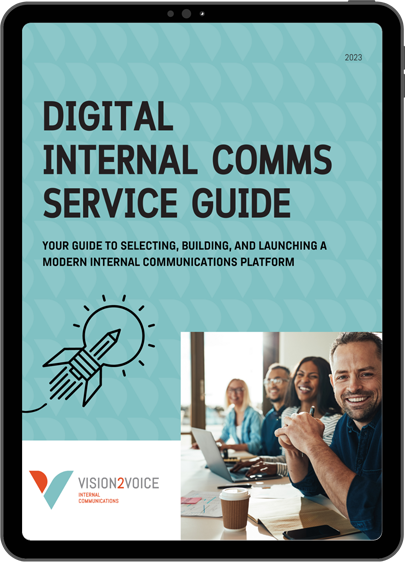
It’s not news to anyone that 2022 seemed to heap crisis on top of crisis – a climate emergency and a global pandemic were joined by the war in Ukraine, sky-high inflation, and increased food insecurity.
It’s been a lot. 😔
And now we are facing down a recession with many companies hedging their bets and laying off large numbers of employees.
It’s a scary time.
But a recession doesn’t have to spell disaster for internal comms. In fact, it is an opportunity to demonstrate how you can add value and help your organization get stronger and better. Adding value was certainly a focus of our agency’s work in 2022, and as I reflected on what’s ahead for 2023, I don’t think this focus should change – in fact, it should be sharpened.
How do internal communications professionals add value and help our organizations survive and thrive during the upcoming recession that experts are predicting? We have three big ideas (with a bonus idea for those who read to the end) 😊
“Storms make trees take deeper roots.” ~ Dolly Parton
BIG IDEA #1: Communicate strategy
There is no better time to make sure everyone is rowing in the same direction then when times are tough. And the best way of doing this is to continually communicate your organization’s strategy and priorities to help employees stay focused on what matters.
A recent study by Donald Sull and Charles Sull found that “during the first six months of the COVID-19 pandemic, organizations that distinguished themselves in terms of communication from top leadership, transparent sharing of information, and strategic clarity, also excelled on multiple measures of agility, including experimentation with new ways of working and flexible processes.”
Yet studies put the percentage of people in organizations who understand strategy at between 10% and 28%. This means (at best) only one person out of four are rowing in the right direction. If you are navigating turbulent waters trying to get to shore, this means one person is rowing in the right direction and the other four are rowing back out to sea. The good news is that employees are craving more information about strategy – it’s something we find in every internal communication audit we do.
This means there is an incredible opportunity for internal communications teams to add value by clearly communicating the organization’s strategy across the organization at every level, and at every opportunity. Never communicate the organization’s strategy once and then call it done. Strategy should be part of EVERY communication and every communication should be connected to the organization’s strategy. Promoting a new rewards and recognition program? Explain how it supports the company strategy. Organizing a company town hall? Make sure the corporate strategy and priorities are high on the agenda. Announcing the acquisition of a new company? Explain how it benefits the company strategy.
BIG IDEA #2: Connect people to culture
You can’t deliver on your company strategy if employees don’t have the right mindsets and behaviours. It’s one thing for them to understand priorities, but it is a whole different ballgame when they understand how to achieve those priorities. For example, if your company is focused on being a leader in a particular market, your employees need to understand what it takes to get there. Is it exceptional customer service, innovative products, fantastic product support?
I’ve been laughing (and quietly screaming) every time I read a news report about a leader who talks about how bringing people back to the office is necessary to build culture. Newsflash: culture doesn’t live in a building.
Culture is the collective mindsets, behaviours, values, and purpose that are brought to life in the stories we tell, and the communication shared by leaders at all levels. That’s precisely where internal communications professionals can add value – by connecting people to culture and by activating it in new ways.
To understand how to build culture, we need only to look at how Indigenous peoples used stories to share ways of knowing. These stories have survived thousands of years (and without smart phones) passing knowledge and culture down from generation to generation. Stories bring people together and helped them make sense of the world. In organizations today, using storytelling to connect people to culture is far more powerful than demanding people trek to the office only to spend the day in Zoom meetings.
During a recession, using stories to build resilience, commitment and to nurture a great culture can help you keep your best people. A classic example, is how Nordstrom build a culture of customer service excellence through stories like the one about the woman who lost the diamond in her ring and how Nordstrom employees went the extra mile to find it for her. Ask any Nordstrom employee and they’ll tell you the story.
BIG IDEA #3: Harness the collective intelligence of your employees through listening
To get a full picture of the challenges and opportunities ahead requires listening your employees who are the best source of ideas for thriving and surviving tough times.
While listening has never been an easy task, remote and hybrid work makes it easy for problems to go undiscovered. This doesn’t mean you need to bring people back to the office. Because, let’s face it, when we were all in the office the listening wasn’t so great either.
Internal communications professionals can add value in turbulent times by helping their organization harness ideas, concerns, and problems.
If anyone has asked for employee feedback in a newsletter article or a town hall, they’ll know that familiar feeling of silence when asking employees to speak up. That silence is usually a good indication of a lack of psychological safety, which is defined as not feeling safe to come forward with ideas, concerns, or mistakes. Much has been written about psychological safety particularly by Amy C. Edmondson, but one of the best ways internal communications professionals can contribute to building it in their organizations is to emphasize in communication how valuable employees’ ideas and concerns are to leaders.
It struck me as odd (but also oddly exciting) this summer when interviewing top executives as part of an internal communications audit that most of leaders were excited we were talking to their people. Odd because they interact with their employees every day and if they are that interested in better understanding employees, it should be easy for them to just ask – right? Yet for some reason this rarely happens.
Developing an intentional listening strategy can harness employee voices, strengthen trust, and demonstrate respect. We find creating a specific strategy focused on listening is an excellent way of making sure your communication efforts have the right balance.
Bonus Idea
I can’t write a blog about tough times without acknowledging the importance of adding value by making sure that internal communication contributes to a more human organization. A human organization not only enables people to their best, but cares for them through the worst.
The real test of a great employee experience is how people are treated when times are tough. This is the time to show empathy your employees who are feeling the crunch of higher interest rates, food prices or a loss of income. Communication isn’t rocket science and creative, empathetic communication costs nothing but will build goodwill and trust.
Start today
A recession is a natural part of the business cycle and doesn’t have to spell disaster. In fact, it can be a great time for individual companies to stand out both in the marketplace and build a brand as a great employer. Start now with our three big ideas.
Inspired by our three big ideas but don’t know how to implement them? reach out to us today. We can’t wait to use internal comms to help your organization thrive.






